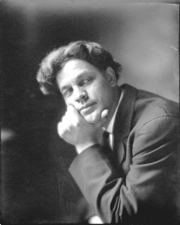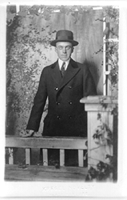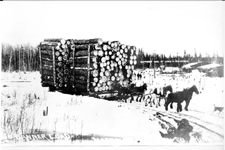|
In a hurry? Save or print these Collection Connections as a single file.
Go directly to the collection, The Northern Great Plains, 1880-1920: Photographs from the Fred Hultstrand and F.A. Pazandak Photograph Collections, in American Memory, or view a Summary of Resources related to the collection.
The Northern Great Plains, 1880-1920 affords students the opportunity to develop their skills in working with photographic historical documents on a variety of levels. And with these images, they can make in-depth explorations of historical subjects, devise questions and strategies for research, and consider controversial historical issues with a sense of their relevance to real past events and present conditions in America.
Chronological Thinking
Using the collection, students can trace change through time in a variety of subjects. They can follow the history of a town or settlement in images and trace the evidence of what settlers might have seen as progress. In one project, students can display a chronology of these images, concluding with a contemporary depiction of their topic, taken from magazines or newspapers, or drawn from imagination.
Other topics include landscape, architecture, clothing, transportation, leisure, and standard of living. An extended study of industrialization is also possible. Using the Special Presentation of "Implements Used on the Farm" and the Pazandak Special Presentations, and doing outside research on inventions, students can use the photographs to create a timeline of technology that changed the frontier.
Historical Comprehension

Digging out after a three-day snowstorm about 1913.
|
|
Students have the opportunity, with this collection, to gain an in-depth understanding of frontier settlement. The collection's images provide evidence of the look and feel of frontier life in a way that only photographs can. Furthermore, the scope of the collection exposes students to multiple aspects of settlement. These include the roles of technology and immigration, farming, weather and climate, daily life, social life and community, and even the costs of settlement upon the land and upon Native American people and culture. Students can supplement this visual data with stories and letters from California As I Saw It: First Person Narratives, 1849-1900 and Pioneering the Upper Midwest, ca. 1820-1910 by searching pioneer, or agriculture. These documents afford comparisons of settlement in different regions and at different times that will also enrich students' understanding.
|
Using these and other resources, students can create a board-game in which each space represents a step in the process of settlement. One game might reflect the challenges facing an immigrant family as they travel to and across America to settle in the Northern Great Plains. Another might include the steps of farming as explained in "Implements Used on the Farm". To move ahead a space, each player must successfully meet a challenge. That challenge might be answering questions about settlement or matching captions with images from the collection. A successful pioneer will get across the board and through the process of settlement as quickly as possible. Students can be creative about constructing and decorating their game boards, drawing on the collection's photographs.
Historical Analysis and Interpretation
|
Students can learn to analyze and interpret photographs by regarding them as the creative work of specific photographers. Have students read the Pazandak and Hultstrand biographies and consider the following questions.
- What were each man's interests?
- What were Pazandak and Hultstrand's reasons for taking photographs and why did they like the medium?
- What did Pazandak and Hultstrand choose to photograph? What aspects of life did each man choose to leave out of his work?
- What do the captions suggest about the photographers' attitudes toward their subjects and toward photography? What do they suggest about the purpose of the photographs and their audience?
- How are the photographers' interests and motives reflected in their photographs?
- How does this change the way one looks at them?
|

Fred Hultstrand portrait.
|

F.A. Pazandak.
|
Students may want to compare Hultstrand and Pazandak's photographs with those of reform photographer, Jacob Riis, or those of the FSA-OWI photographers. How are the interests and goals of these photographers different from those of Pazandak and Hultstrand? How is that reflected in their work? The WPA photographers were largely concerned with social issues of the 1930s and 40s. To what extent are Pazandak and Hultstrand photographers of the pioneer era or frontier community? How much were their interests, not only as photographers, but as people, shaped by their time and location? Has a type of photographer and photograph passed from history with the frontier community?
|
Historical Issue Analysis and Decision Making
|
The collection includes evidence of various changes that, while having many benefits, have also had several costs. For example, settlement allowed many people to establish homes and to make the land productive. However, this was achieved through the depletion of natural resources and the forced removal of Native Americans from their homeland.
Similarly, large-scale farming and ranching, known as bonanzas, made large profits in North Dakota in the late 1800's. However, not everyone had the capital to run such an operation and small farmers, already oppressed by the high interest rates of banks and railroads, felt the weight of such competition and inequity.
|
|

Banner load, Blackduck, Minnesota : biggest load of logs ever hauled / by Lewis H. Halvorson.
|

Wheat grain shocks, taken on the Grandin Farm close to Mayville, North Dakota.
|
|
Finally, modernization has caused many changes of which students may question the value. Change is illustrated within the collection with, for example, images of automobiles replacing images of bicycles. What have automobiles allowed us to do? How have they affected the environment? How have they shaped our culture? Students can also see changes by comparing images from the collection with contemporary images.
|
Ask them to consider and explain the benefits and costs of a major change represented in the collection. Students may also want to refer to the "North Dakota Historical Overview" and the online collection, Evolution of the Conservation Movement, 1850-1920.
Historical Research Capabilities

Celebration on Main Street : Park River, North Dakota.
|
|
The collection provides visual data that students can bring to their research into a variety of topics including the frontier, small-town rural America, North Dakota or the Northern Great Plains, agriculture and technology, pioneer communities, incorporation and industrialization at the turn of the century, immigration, and third-party politics. Furthermore, photographs can provide creative starting points for original research topics based on students' own questions and observations. For example, in examining the picture on the left, a student might wonder what kinds of flags are depicted hanging across the street, or what the people are celebrating. These questions could lead to research into immigration and its role in the creation of frontier culture and community. Or, one of the photographs documenting Fourth of July celebrations might lead to an inquiry into the role of this holiday and its celebration in small-town rural America at the turn of the century.
|
|



